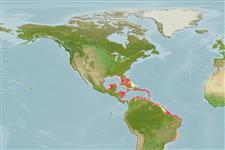>
Eupercaria/misc (Various families in series Eupercaria) >
Haemulidae (Grunts) > Haemulinae
Etymology: Anisotremus: Greek, anisos = unequal + Greek, trema, -atos = hole (Ref. 45335).
More on author: Linnaeus.
Environment: milieu / climate zone / depth range / distribution range
Écologie
marin récifal; profondeur 2 - 70 m (Ref. 9710). Subtropical; 32°N - 33°S, 98°W - 34°W
Western Atlantic: Bermuda (introduced) and Florida, USA to Brazil, including the Gulf of Mexico and the Caribbean Sea (Ref. 9626).
Taille / Poids / Âge
Maturity: Lm ? range ? - ? cm
Max length : 40.6 cm TL mâle / non sexé; (Ref. 40637); common length : 25.0 cm TL mâle / non sexé; (Ref. 3798); poids max. publié: 930.00 g (Ref. 40637)
Épines dorsales (Total) : 12; Rayons mous dorsaux (Total) : 16 - 18; Épines anales: 3; Rayons mous anaux: 9. Body striped yellow and silvery blue; fins yellow, 2 black bars: one from nape through eye to mouth, another from origin of dorsal fin to base of pectoral fin. Only grunt fish in the Caribbean with two vertical black bars and yellow stripes. (Ref. 26938).
Maximum depth from Ref. 126840. Inhabits reefs and rocky bottoms. Feeds at night on mollusks, echinoderms, annelids, and crustaceans (Ref. 3798). Young pick parasites from the bodies of larger fishes (Ref. 5521). Young are popular aquarium fish (Ref. 7251). Marketed fresh (Ref. 3798). Has been reared in captivity (Ref. 35420).
Life cycle and mating behavior
Maturité | Reproduction | Frai | Œufs | Fécondité | Larves
Distinct pairing during breeding (Ref. 205).
Robins, C.R. and G.C. Ray, 1986. A field guide to Atlantic coast fishes of North America. Houghton Mifflin Company, Boston, U.S.A. 354 p. (Ref. 7251)
Statut dans la liste rouge de l'IUCN (Ref. 130435: Version 2024-1)
Menace pour l'homme
Reports of ciguatera poisoning (Ref. 30303)
Utilisations par l'homme
Pêcheries: intérêt commercial mineur; pêche sportive: oui; Aquarium: Aquariums publics
Outils
Articles particuliers
Télécharger en XML
Sources Internet
Estimates based on models
Preferred temperature (Ref.
123201): 24.9 - 28.2, mean 27.4 °C (based on 791 cells).
Phylogenetic diversity index (Ref.
82804): PD
50 = 0.5039 [Uniqueness, from 0.5 = low to 2.0 = high].
Bayesian length-weight: a=0.01514 (0.00889 - 0.02578), b=3.05 (2.90 - 3.20), in cm total length, based on LWR estimates for this species & (Sub)family-body (Ref.
93245).
Niveau trophique (Ref.
69278): 3.6 ±0.5 se; based on diet studies.
Résilience (Ref.
120179): Milieu, temps minimum de doublement de population : 1,4 à 4,4 années (Preliminary K or Fecundity.).
Fishing Vulnerability (Ref.
59153): Low to moderate vulnerability (31 of 100).
Nutrients (Ref.
124155): Calcium = 22.6 [10.1, 62.8] mg/100g; Iron = 0.538 [0.258, 1.056] mg/100g; Protein = 19.6 [17.7, 21.7] %; Omega3 = 0.144 [0.066, 0.285] g/100g; Selenium = 13.1 [5.8, 27.3] μg/100g; VitaminA = 35.1 [9.5, 131.4] μg/100g; Zinc = 0.673 [0.404, 1.106] mg/100g (wet weight);
